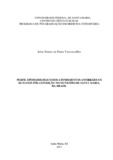| dc.creator | Vasconcellos, Jaíne Soares de Paula | |
| dc.date.accessioned | 2017-08-07T13:49:02Z | |
| dc.date.available | 2017-08-07T13:49:02Z | |
| dc.date.issued | 2017-01-16 | |
| dc.identifier.uri | http://repositorio.ufsm.br/handle/1/11307 | |
| dc.description.abstract | Rabies is a viral zoonosis that presents progressive and lethal development in almost 100% of cases. Besides being a disease of great importance for the costs generated in livestock and human rabies treatments. The objective of this study was to define the epidemiological profile of human rabies in the municipality of Santa Maria, Rio Grande do Sul, Brazil, from 2010 to 2015. Data from the Notification of Invalidity Information System (Sistema de Informação de Agravo de Notificação, SINAN) were obtained. Through the completion of individual records of human rabies cases (ICD10-W64). The data were analyzed with the aid of the Tabwin® program and later exported to the Excel® program, forming a database that was organized and analyzed using R® software. Thus, post-exposure rabies treatments occurred in 55.0% of the cases in females and 45.0% in males. The highest occurrence (54.5%) was observed in the age group from 20 to 59 years. Mainly, 87.5% of registered cases were caused by canine and 10.9% feline animals. The site of exposure that obtained the highest number of attacks by canine bite was the lower limb with 22.1%. It was possible to observe indications of precipitated treatments, both in cases of indirect contacts and in cases in which the animals were healthy, observable and negative clinically or laboratorially for the disease. There was a large number of fields contained in the mandatory notification form which were ignored at the time of filling. It is suggested a program for training of the professionals involved with this aggravation and the dissemination of information aimed an instrumentalizing for the users about the accidents. An informative folder containing the main information to be transmitted to the residents was developed. In addition, a flow chart was drawn up guiding the actions against the anti-rabies visits to be applied in the city. | eng |
| dc.description.sponsorship | Coordenação de Aperfeiçoamento de Pessoal de Nível Superior - CAPES | por |
| dc.language | por | por |
| dc.publisher | Universidade Federal de Santa Maria | por |
| dc.rights | Attribution-NonCommercial-NoDerivatives 4.0 International | * |
| dc.rights.uri | http://creativecommons.org/licenses/by-nc-nd/4.0/ | * |
| dc.subject | Raiva | por |
| dc.subject | Mordedura | por |
| dc.subject | Epidemiologia | por |
| dc.subject | Vigilância epidemiológica | por |
| dc.subject | Notificação | por |
| dc.subject | Bite | eng |
| dc.subject | Epidemiology | eng |
| dc.subject | Epidemiological surveillance | eng |
| dc.subject | Notification | eng |
| dc.title | Perfil epidemiológico dos atendimentos antirrábicos humanos pós-exposição no município de Santa Maria, RS, Brasil | por |
| dc.title.alternative | Epidemiological profile of human anti-rabies attendance posts exposure in the city of Santa Maria, RS, Brazil | eng |
| dc.type | Dissertação | por |
| dc.description.resumo | A raiva é uma zoonose viral que apresenta desenvolvimento progressivo e letal em quase a totalidade dos casos. Além disso, é uma doença de grande importância econômica, especialmente relacionada aos custos gerados na pecuária e nos tratamentos antirrábicos humanos. O objetivo deste estudo foi avaliar o perfil epidemiológico dos atendimentos antirrábicos humanos pós-exposição no município de Santa Maria, Rio Grande do Sul, Brasil. Foram utilizados os dados do Sistema de Informação de Agravo de Notificação (SINAN), obtidos no período de 2010 a 2015, por meio da busca das fichas de investigação individuais dos atendimentos antirrábicos humanos, notificadas no município. Os dados foram analisados com o auxílio do programa Tabwin® e posteriormente exportados para o programa Excel®, formando um banco que foi organizado e analisado utilizando-se o software R®. Desta forma, os atendimentos antirrábicos pós exposição ocorreram em 55,0% dos casos em pessoas do sexo feminino e 45,0% em masculino. A maior ocorrência (54,5%) foi observada na faixa etária de 20 a 59 anos. Majoritariamente, 87,5% dos agravos registrados foram causados por animais da espécie canina e 10,9% felina. O local de exposição que obteve maior número de ataques por mordedura canina foi o membro inferior (22,1%). Foi possível constatar que ocorreu a indicação de tratamentos de maneira inadequada, tanto em casos de contatos indiretos quanto em casos nos quais os animais eram sadios, observáveis e negativos clínica ou laboratorialmente para a doença. Observou-se um grande número de campos contidos na ficha de notificação obrigatória que não foram preenchidos. Sugere-se capacitações para os profissionais envolvidos e a disseminação de informações visando instrumentalizar os usuários a respeito deste agravo. Um folder informativo contendo as principais informações a serem transmitidas aos munícipes foi desenvolvido. Além disso, foi proposto um fluxograma norteador das ações frente aos atendimentos antirrábicos para o município. | por |
| dc.contributor.advisor1 | Sangioni, Luis Antonio | |
| dc.contributor.advisor1Lattes | http://lattes.cnpq.br/8056805667740451 | por |
| dc.contributor.referee1 | Righi, Liane Beatriz | |
| dc.contributor.referee1Lattes | http://lattes.cnpq.br/5575942071914661 | por |
| dc.contributor.referee2 | Biondo, Alexander Welker | |
| dc.contributor.referee2Lattes | http://lattes.cnpq.br/2978847453165582 | por |
| dc.creator.Lattes | http://lattes.cnpq.br/8545548696134639 | por |
| dc.publisher.country | Brasil | por |
| dc.publisher.department | Medicina Veterinária | por |
| dc.publisher.initials | UFSM | por |
| dc.publisher.program | Programa de Pós-Graduação em Medicina Veterinária | por |
| dc.subject.cnpq | CNPQ::CIENCIAS AGRARIAS::MEDICINA VETERINARIA | por |
| dc.publisher.unidade | Centro de Ciências Rurais | por |



